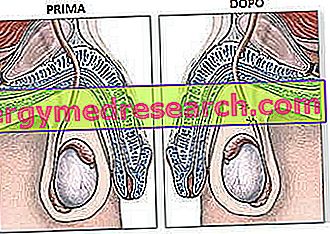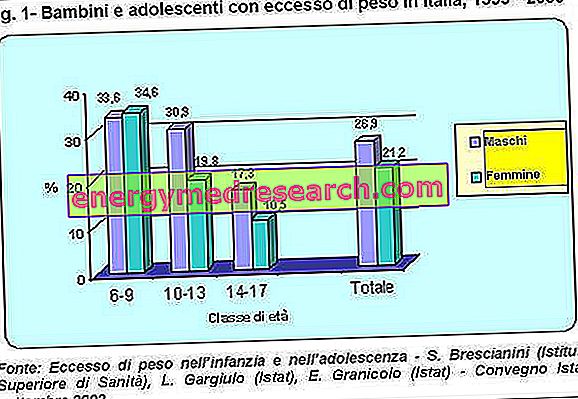Generality
Coagulative C protein is a factor that participates in the formation of clots, limiting its extension. This enzyme is normally present in the blood, but its activity or quantity can be deficient for various reasons. A deficiency of protein C can derive, for example, from congenital factors, hyperconsumption, vitamin K deficiency, intake of estroprogestinici or high levels of estradiol by ovulation induction.

What's this
Protein C participates in the coagulation process together with other factors; together with protein S and antithrombin III, it has the task of counteracting the excessive function of coagulation activity, keeping the blood fluid.
Protein C is synthesized by the liver and transformed into an active enzyme under the action of thrombin in the presence of calcium and phospholipids.
Under normal conditions, after tissue or wall damage to blood vessels, blood loss is blocked due to haemostasis . During this process, the platelets adhere at the injured site, then the reaction that leads to the activation of the coagulation factors (coagulation cascade) is triggered. This causes the formation of a clot that remains until the damage is completely repaired. When it is no longer needed, this sort of "plug" is eliminated.
Protein C cooperates with the S protein for blood clots. In particular, these two elements control the extent of the clot, inactivating specific coagulation factors (factors V and VIII); in other words, the function of protein C is to prevent excessive coagulation .
If there is not a sufficient amount of C and S proteins, or they do not function properly, the clots can form uncontrollably. These situations can be mild to very serious.
Biological role and blood coagulation
Protein C, not to be confused with C-reactive protein, is the most important blood anticoagulant; it therefore shares the same biological role as antithrombin III, although the mechanisms of action of these proteins, both of hepatic origin, are different. The former is in fact independent of vitamin K, while protein C - which circulates in plasma in an inactive form - requires adequate quantities of this micronutrient to be synthesized.
The main substrates on which protein C acts are the Va factor and the coagulation factor VIIIa. In the presence of thrombin, generated by coagulation, and of thrombomodulin, present on the endothelial surface, protein C is converted into the active form, called active protein C ( APC, which once again has nothing to do with the reactive C protein) . Thanks to this structural modification, the active protein C also acquires a pro-fibrinolytic activity (promotes the dissolution of the clot), which is performed through the inhibition of PAI-1 (inhibitor of the plasminogen activator).
Protein C is also associated with anti-inflammatory and cytoprotective activities.
Another protein, called S protein (APS), is a natural cofactor of APC, also vitamin K - dependent.
Finally, remember that thrombin (factor IIa) converts fibrinogen into an insoluble fibrin polymer, which participates in the formation of the clot. This pro-coagulant action contrasts with its ability to activate protein C, which therefore represents an endogenous control against excessive activity of the coagulation system.
Why do you measure
Examination of the coagulative C protein is performed for:
- Establish the causes of inappropriate formation of a thrombus (thrombotic event or venous thromboembolism);
- Diagnosing disorders that cause excessive clotting;
- Detect inherited or acquired deficiencies of the same protein C or protein S, with which it cooperates in the coagulation process.
To evaluate protein C, two types of tests are available:
- Functional examination : measures the activity of protein C, focusing on the ability to regulate and reduce the formation of clots. The decrease in activity can be due to a reduced quantity of the parameter or, more rarely, to the presence of non-functional forms.
- Immunological analysis : establishes the amount of protein C present in the blood sample taken from the patient.
This information can be useful to determine the type of deficit, its severity and whether this is due to an acquired or hereditary defect.
When is the exam prescribed?
Examination of the coagulative protein C allows to measure its quantity and evaluate its functionality.
This analysis is generally indicated after an unexplained thrombotic event, as a support to the diagnosis of hypercoagulation disorders, especially in young subjects (less than 50 years old) and / or who have no other obvious reasons for manifesting this phenomenon.
Protein C testing may also be required for multiple abortions. Furthermore, it is very important to check the values of this protein before taking oral contraceptives ; in women at risk, drugs based on estrogens and progestins could cause venous thrombosis or other cardiovascular disorders.
Evaluation can also be recommended when a patient has a close family member who has an inherited protein C deficiency.
Normal values
As for the immunological dosage, the normal values of protein C in the blood are in the range 48 - 80 nmol / L (3-5 mg / L).
The functional examination (activity of protein C with respect to a reference range) is equal to 70-130% (in functional units: 0.7 - 1.3 U / ml).
Note : the reference interval of the exam can change according to age, sex and instrumentation used in the analysis laboratory. For this reason, it is preferable to consult the ranges listed directly on the report. It should also be remembered that the results of the analyzes must be assessed as a whole by the general practitioner who knows the patient's medical history.
Protein C High - Causes
An increase in protein C can be observed in the event of:
- Taking androgenic drugs;
- Diabetes;
- Nephritic syndrome.
High values of protein C are not usually associated with medical problems and / or pathological consequences, therefore they are not considered clinically relevant.
Low Protein C - Causes
The protein C deficiency or lack of activity may be due to:
- Acquired disorders, such as liver or kidney disease, severe infections, cancer;
- Hereditary alterations (transmitted from parents to children).
Congenital protein C deficiencies may depend on:
- Synthesis deficit;
- Protein synthesis with reduced biological activity for:
- Reduced ability to bind to protein S;
- Reduced degradation capacity of factors V and VIII.
Protein C deficiencies - congenital or acquired - lead to hypercoagulability (or a prothrombotic state).
Low protein C: increased risk of venous thrombosis
Protein C deficiency may have a congenital (inherited) or acquired origin.
In the latter case they are typically associated with:
- Liver disease (cirrhosis, liver failure, chronic hepatitis) and kidney disease;
- Excessive consumption (as in disseminated intravascular coagulation);
- Vitamin K deficiency;
- Post-operative states;
- Coumarin anticoagulant therapy (such as coumadin®);
- Severe infections.
Often, in these acquired forms, other anticoagulants, such as antithrombin III, are also decreased.
A protein C deficiency results in a reduction in blood anticoagulant activity or, if you prefer, in a state of thrombophilia; consequently, the risk of abnormal clots (called thrombi) forming in the blood vessels increases. These "lumps" can go against spontaneous dissolution, grow to the point of obstructing the vase in which they originate or breaking, migrating in a circle and ending, sometimes, with the occlusion of a smaller vessel. The most feared consequences of this condition, called thrombosis, are the cardiac infarct, stroke and pulmonary embolism; it must be said, however, that arterial thromboses are rather rare in the presence of protein C deficiency, which exposes above all to a greater risk of venous thrombosis and its consequences.
Hereditary protein C deficiencies are classified into:
- Type I deficiency (where there are low levels of the protein - quantitative defect);
- Type II deficiency (less common, in which the functional activity of the protein decreases - qualitative defect).
In an exceptional way the two conditions can coexist (a particularly rare event in the population), causing severe thrombotic phenomena, sometimes with a fatal course, already at an early age, such as fulminant purpura in the newborn, deep vein thrombosis of the lower limbs and necrosis dermal in association with oral use of coumarin anticoagulants. This last phenomenon can be absurd, since at the beginning of the therapy the pharmacological inactivation of protein C may be higher than that of vitamin K coagulation factors - dependent (II, VII, IX and X), with a consequent increase of coagulation mechanisms and necrosis of skin areas. In heterozygotes the consequences of the deficit are less serious and have varying intensities by virtue of the possible presence of other predisposing factors, which may be endogenous (for example deficiency of other anticoagulant factors, such as anthrombin III, protein S etc.) or external (surgery, use of oral contraceptives, pregnancy).
There is another inherited disease, much more common than the previous ones (incidence 3 - 7% in the healthy population), characterized by resistance to activated protein C. In practice, protein C activates normally but fails to adequately inhibit the Va and VIIIa factors of coagulation. Therefore, if increasing concentrations of activated protein C are added to a blood sample taken from a resistant subject, there is no adequate prolongation of the coagulation time (it is logical to expect). Responsible for this anomaly is in the vast majority of cases (more than 90%) a mutation in the Factor V gene (Factor V Leiden), which involves an amino acid substitution in the mature protein. The repercussions of activated protein C resistance also depend on the overlap or otherwise of other factors, such as those responsible for acquired deficiencies (pregnancy, trauma, surgery or use of oral contraceptives). Factor V Leiden is the most common cause of genetic thrombophilia and in testing laboratories there are specific tests to diagnose this condition of resistance to the action of active protein C; if necessary, the therapy uses anticoagulant drugs.
How to measure it
Protein C examination is performed on a venous blood sample taken from the arm.
Preparation
- Before harvesting, it is necessary to observe a fast of at least 8 hours, during which a small quantity of water is allowed.
- In the two weeks preceding the analysis, oral warfarin (Cumadin®) therapy should be discontinued.
- Before undergoing the examination, the patient must wait 10 days after the thrombotic event.
Interpretation of Results
- Normal activity and amounts of protein C indicate good regulation of coagulation.
- High values of protein C are not usually associated with medical problems, therefore they are not considered clinically relevant.
- A low value of protein C is associated with the tendency to excessive and inappropriate clot formation. If the protein is not functional, the coagulation process does not work sufficiently; this can lead to an increase in the probability of developing a clot that hinders blood flow in the veins (venous thromboembolism, VTE), but the extent of the risk depends on how poorly or deficiently the protein is.



